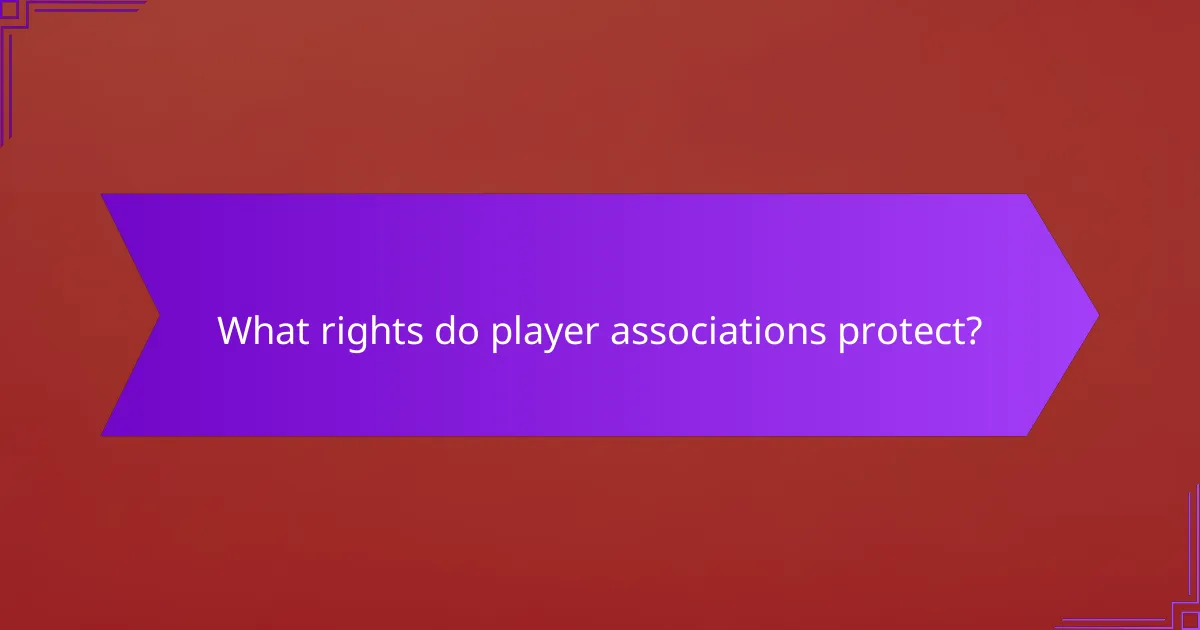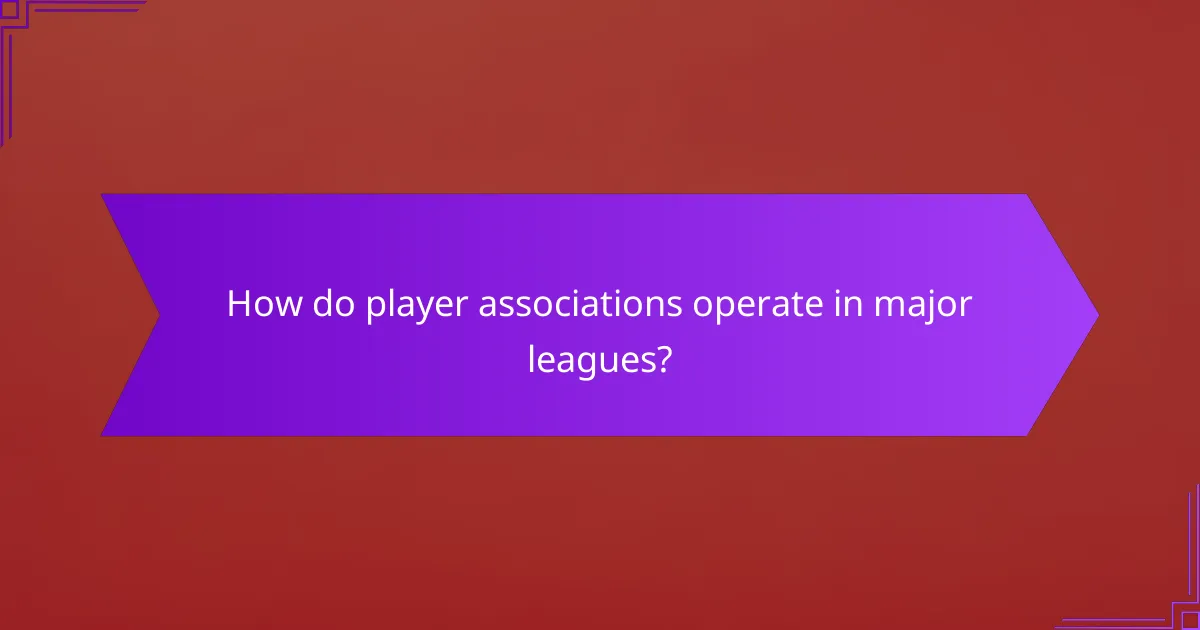Player associations are vital in advocating for athletes’ rights and shaping governance within sports. By engaging with governing bodies, they influence policies that directly impact players’ careers and welfare, ensuring their voices are heard in critical decision-making processes. These associations also protect essential rights, such as collective bargaining and health regulations, promoting the professional integrity and safety of athletes.

How do player associations influence governance in sports?
Player associations play a crucial role in shaping governance in sports by advocating for athletes’ rights and interests. They engage in discussions with governing bodies to influence policies, ensuring that players have a voice in decision-making processes that affect their careers and welfare.
Impact on policy-making
Player associations significantly impact policy-making by representing athletes’ perspectives in discussions with sports organizations. They lobby for regulations that protect players’ rights, such as fair pay, health and safety standards, and anti-discrimination measures. This influence can lead to the establishment of more equitable policies that benefit all athletes.
For example, associations often push for collective bargaining agreements that set minimum salary thresholds and working conditions, which can uplift the entire sport’s standards. The presence of a strong player association can lead to more transparent governance structures within sports organizations.
Role in contract negotiations
Player associations assist athletes in contract negotiations, ensuring they receive fair compensation and favorable terms. They provide resources, legal support, and negotiation expertise, which can be particularly beneficial for younger or less experienced players. This support helps athletes navigate complex contracts and avoid unfavorable agreements.
Associations often negotiate collective agreements that establish baseline contract terms for all players, which can include salary caps, bonus structures, and benefits. This collective approach empowers athletes and levels the playing field in negotiations with teams and sponsors.
Examples of successful advocacy
There are numerous instances where player associations have successfully advocated for athletes’ rights. For example, the National Football League Players Association (NFLPA) has been instrumental in securing improved health benefits and player safety protocols in the NFL. Their efforts have led to significant changes in concussion protocols and injury management.
Another notable example is the Professional Footballers’ Association (PFA) in the UK, which has worked to ensure fair wages and job security for players, particularly during economic downturns. These successful advocacy efforts demonstrate the power of player associations in influencing governance and protecting athletes’ interests across various sports.

What rights do player associations protect?
Player associations protect a range of rights essential for the welfare and professional integrity of athletes. These rights include collective bargaining, health and safety regulations, and intellectual property rights, ensuring that players have a voice and are safeguarded in their professional environments.
Collective bargaining rights
Collective bargaining rights allow player associations to negotiate contracts on behalf of their members, ensuring fair wages and working conditions. This process typically involves discussions with leagues or governing bodies to establish terms that benefit the players collectively.
For instance, in sports like football and basketball, player associations often negotiate salary caps, revenue sharing, and benefits such as retirement plans. These agreements can significantly enhance players’ financial security and overall job satisfaction.
Health and safety regulations
Health and safety regulations are crucial for protecting players from injuries and ensuring their well-being during training and competition. Player associations advocate for standards that promote safe playing conditions and access to medical care.
For example, associations may push for mandatory health screenings, concussion protocols, and guidelines for safe training practices. These regulations help to minimize risks and provide players with the necessary support to maintain their health throughout their careers.
Intellectual property rights
Intellectual property rights protect the unique branding and image of players, allowing them to control how their likeness and personal brand are used commercially. Player associations work to ensure that athletes receive fair compensation for endorsements and merchandise that feature their names or images.
For instance, when a player signs a deal for merchandise or advertising, their association ensures that the terms reflect the player’s market value. This protection is vital for athletes, as it can significantly impact their earning potential beyond their playing contracts.

How do player associations operate in major leagues?
Player associations in major leagues function as collective bargaining entities that represent the interests of athletes. They negotiate contracts, advocate for player rights, and ensure fair treatment within the league’s governance structure.
Structure of the NFL Players Association
The NFL Players Association (NFLPA) is structured as a labor union that represents all players in the National Football League. It is governed by an executive committee elected by player members, which oversees the association’s operations and strategic direction.
Members pay dues, which fund the association’s activities, including legal representation and collective bargaining. The NFLPA also employs staff to handle various functions, such as player education and advocacy for health and safety standards.
Functions of the NBA Players Association
The NBA Players Association (NBPA) serves to protect the rights and interests of basketball players in the National Basketball Association. Its primary functions include negotiating the collective bargaining agreement, which outlines salary caps, revenue sharing, and player benefits.
Additionally, the NBPA provides resources for player development, including financial planning and career transition services. The association also plays a role in addressing social justice issues, ensuring that players can voice their opinions on important matters.
Comparative analysis of MLB and NHL associations
The Major League Baseball Players Association (MLBPA) and the National Hockey League Players’ Association (NHLPA) both serve similar roles in their respective leagues, but they differ in structure and negotiation strategies. The MLBPA is known for its strong history of collective bargaining success, often securing favorable terms for players, while the NHLPA has faced challenges in negotiations, particularly regarding salary caps and revenue sharing.
In terms of membership, the MLBPA represents a larger number of players, which can complicate negotiations due to diverse interests. Conversely, the NHLPA’s smaller membership allows for more streamlined decision-making, but it also means that player representation can be less robust in certain areas.

What are the challenges faced by player associations?
Player associations encounter several challenges that can hinder their effectiveness in advocating for athletes’ rights and interests. These challenges include negotiation hurdles, public perception issues, and legal battles with leagues.
Negotiation hurdles
Negotiation hurdles arise when player associations attempt to reach agreements with leagues or clubs. These challenges can stem from differing priorities, financial constraints, and power dynamics that favor the leagues. For instance, player associations may struggle to secure favorable contract terms or benefits due to the leagues’ control over revenue distribution.
To navigate these hurdles, player associations should prioritize clear communication and establish a unified stance among players. Engaging in thorough research to understand the financial landscape can also empower associations during negotiations.
Public perception issues
Public perception issues can significantly impact the effectiveness of player associations. Negative media portrayals or public misunderstandings about the associations’ goals can undermine their credibility. For example, if the public views player associations as overly demanding or disconnected from fans, it can lead to decreased support for their initiatives.
To combat these perception challenges, associations should focus on transparency and proactive communication. Highlighting positive outcomes achieved for players and engaging with fans through social media can help improve public opinion.
Legal battles with leagues
Legal battles with leagues often arise when player associations seek to enforce rights or challenge unfair practices. These disputes can be costly and time-consuming, diverting resources away from advocacy efforts. Common issues include contract disputes, labor relations, and compliance with regulations.
Player associations should be prepared for potential legal challenges by establishing strong legal frameworks and maintaining open lines of communication with legal experts. Understanding the relevant laws and regulations can also help associations navigate these complex situations effectively.

How do player associations impact player welfare?
Player associations significantly enhance player welfare by advocating for rights, providing support services, and ensuring fair treatment within professional sports. These organizations focus on various aspects of player well-being, including mental health, financial education, and career transitions.
Support programs for mental health
Player associations often implement mental health support programs to address the psychological challenges athletes face. These initiatives may include access to counseling services, workshops on stress management, and peer support networks.
For example, associations might partner with mental health professionals to offer confidential resources, ensuring players can seek help without stigma. Regular mental health check-ins can also be part of these programs, promoting ongoing well-being.
Financial literacy initiatives
Financial literacy initiatives provided by player associations aim to equip athletes with essential money management skills. These programs typically cover budgeting, investment strategies, and understanding contracts, helping players make informed financial decisions.
Workshops and seminars led by financial experts can guide players on how to manage their earnings effectively, especially during their playing careers and beyond. This education is crucial, as many athletes face financial challenges after retirement due to a lack of planning.
Career transition assistance
Career transition assistance is a vital service offered by player associations to help athletes navigate life after sports. This support often includes career counseling, networking opportunities, and access to job placement services.
Associations may also provide resources for skills development, enabling players to explore various career paths. By preparing athletes for post-sport careers, these programs help ensure a smoother transition and long-term success outside of athletics.

What are the prerequisites for forming a player association?
To form a player association, a group of players must meet specific legal and organizational criteria. This typically involves establishing a formal structure, adhering to local laws, and ensuring representation of the players’ interests.
Legal requirements
Legal requirements for forming a player association vary by country but generally include registering as a non-profit organization or union. This process often requires a constitution or bylaws that outline the association’s purpose, governance structure, and membership criteria.
In many jurisdictions, a minimum number of members is necessary to establish legitimacy, often ranging from a few dozen to several hundred players. Additionally, compliance with labor laws and regulations regarding collective bargaining may be essential for the association to operate effectively.
It is crucial to consult local legal experts to navigate the specific requirements and ensure that the association is recognized by relevant sports governing bodies. Failure to meet these legal prerequisites can hinder the association’s ability to advocate for player rights and interests.



